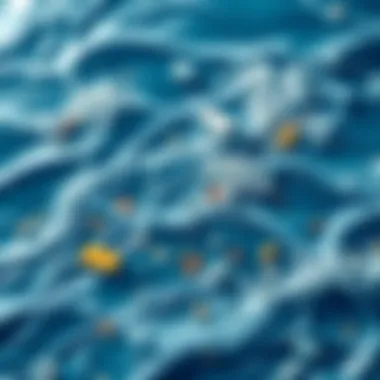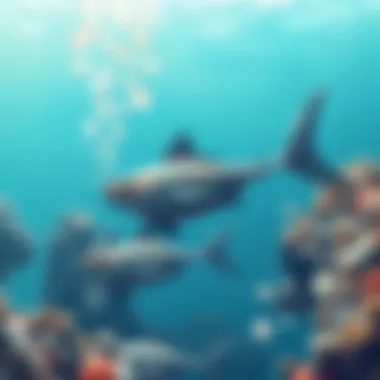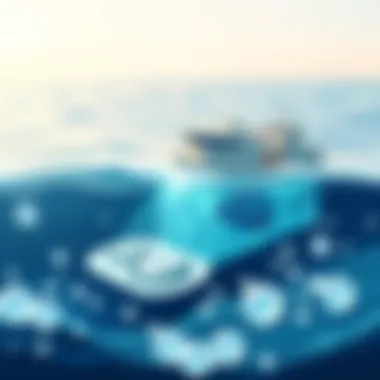Strategies and Challenges in Oceanic Pollution


Intro
Ocean pollution is a mounting crisis, drawing attention globally due to its repercussions on both oceanic ecosystems and human health. The vast bodies of water that cover our planet serve as a crucial resource for life, not only providing sustenance but also playing a role in climate regulation. Yet, our oceans are drowning under the weight of pollution, from plastics choking marine life to chemicals altering habitats.
This article aims to deliver a thorough look into the sources and types of ocean pollution, the impact of this crisis, and the ongoing efforts to rectify it. As we meander through the pathways of invasive waste and hazardous materials, we uncover a complex landscape where technology meets ecology. In addition, we will shed light on the legislative frameworks influencing cleanup initiatives and explore the innovative ideas that are steering us toward cleaner, healthier oceans.
By engaging with this essential topic, readers will gain insights into both the challenges we face and the strategies we can employ to combat ocean pollution effectively. This piece serves as a crucial resource for researchers, policymakers, and environmentally conscious individuals eager to play a role in the preservation of our marine environments.
Let’s navigate these murky waters together.
Foreword to Ocean Pollution
Understanding ocean pollution is more than just environmental jargon; it's a crucial conversation about the health of our planet. Oceans are the lifeblood of Earth, covering over 70% of its surface and hosting a vast array of life. From the tiniest plankton to the largest whales, every organism relies on these waters. Thus, when pollution infiltrates our oceans, the reverberations are felt not only in marine environments but across all ecosystems, including human ones.
When we talk about ocean pollution, we're addressing a multitude of factors, each with its unique sources and implications. We see plastic waste cluttering the shores, heavy metals seeping through the soil and into the waters, and nutrient overloads causing harmful algal blooms. Each type of pollutant poses distinct challenges and necessitates tailored strategies for remediation.
The importance of tackling oceanic pollution is underscored by several key elements:
- Environmental Health: Healthy oceans contribute directly to the overall wellbeing of the planet. When polluted, these bodies of water can lead to biodiversity loss and habitat destruction.
- Economic Impacts: Many industries, from tourism to fishing, depend on clean oceans. Pollution threatens livelihoods and, in broader terms, economic stability.
- Public Health Concerns: Contaminants can cycle back into the human food chain, leading to health risks that affect communities globally.
In this article, we’ll delve deeper into the specifics of what ocean pollution entails, revisit its historical roots, and address how society has coped with these challenges over the years.
Defining Ocean Pollution
Ocean pollution refers to the introduction of harmful substances into the marine environment, which can disrupt the natural balance of ecosystems. This pollution comes in many forms, such as plastics, chemicals, and other waste material. It spans from the visible to the nearly imperceptible, impacting everything from large marine mammals to microscopic organisms. Understanding this definition is vital for grasping the broader implications of pollution on marine life and human health.
Historical Context of Marine Pollution
To appreciate the current state of ocean pollution, we can take a look back at its historical context. The roots of ocean pollution can be traced back to the Industrial Revolution in the late 18th century when human activities began significantly altering marine ecosystems. Increased industrial activities led to waste—both solid and liquid—being dumped into oceans with little regard for the long-term effects.
In the mid-20th century, events like the Santa Barbara oil spill in 1969 brought substantial public attention to marine pollution issues. This oil disaster underscored the fragility of marine environments and catalyzed a wave of environmental activism and policy changes. Over the decades, various international treaties have emerged to address the pollution crisis, yet challenges persist as we navigate conflicting priorities between industrial growth and environmental protection.
Types of Ocean Pollutants
Understanding different types of ocean pollutants is crucial. It helps us pinpoint the sources and consequences of contamination, allowing for focused clean-up efforts and effective policy-making. By categorizing pollutants, we can tailor strategies to mitigate their impact and enhance the sustainability of marine environments. These pollutants can cause immense damage to marine life, ecosystems, and even human health, thus making it necessary to comprehend their nature and effects.
Plastic Waste
Microplastics
Microplastics are particles smaller than five millimeters that come from various sources, including the breakdown of larger plastic debris. Their widespread presence in oceans poses significant risks. These tiny particles can be ingested by marine organisms, leading to toxic accumulation in the food chain. One noteworthy aspect of microplastics is their ability to attract and absorb harmful chemicals from the water, amplifying their toxicity. This creates a substantial concern for both ocean health and human consumption of seafood. In this article, we note microplastics for their pervasive nature, which threatens not just marine life but also poses health risks for humans due to bioaccumulation.
Large Debris
Large debris, such as discarded fishing nets and plastic bottles, can cause immediate physical harm to marine animals. Turtles can become entangled and suffocate, while whales may ingest large pieces, leading to internal injuries. A significant consideration with large debris is its role in habitat destruction, altering the marine landscape and impacting various species. The concern is not merely about visibility; these items contribute to the breakdown of ecosystems. Highlighting large debris unveils the necessity for targeted removal efforts, emphasizing the importance of community and governmental participation in clean-up initiatives.
Impact on Marine Life
The broader impact of pollution on marine life encompasses both direct and indirect effects. It disrupts food chains, harms reproductive processes, and can lead to higher mortality rates among species. Pollution doesn’t just threaten iconic species like dolphins and sea turtles; it also affects the less glamorous, yet equally vital, organisms that maintain ecosystem balance. Focusing on these impacts highlights the interconnectedness of marine species and underlines the need for immediate action to preserve oceanic integrity. Without attention to the ramifications for marine life, our efforts towards ocean health become incomplete.
Chemical Contaminants
Heavy Metals
Heavy metals, often sourced from industrial run-offs and agricultural practices, linger in marine environments for years. These metals, including lead, mercury, and cadmium, accumulate in the tissues of fish and invertebrates. The key characteristic of heavy metals is their toxicity; even in small amounts, they can lead to reproductive failures and neurological issues in marine species.
Discussing heavy metals allows us to understand the long-term effects of industrial practices on ocean health. The complexity of their chemical nature means that they do not break down, trapping both marine organisms and humans in a vicious cycle of contamination and health risks.
Pesticides
Pesticides are another form of chemical contaminant, mainly entering the ocean through agricultural runoff. They can lead to drastic biocides, affecting the survival of non-target species. Their characteristic is not just toxicity; it’s also their ubiquity in farming practices across the globe. A challenge posed by pesticides is their potential to disrupt water quality and harm sensitive marine habitats.
Why is it crucial to include pesticides in this discussion? Their persistent nature can hinder biodiversity in marine ecosystems. Addressing pesticides contributes to understanding how agricultural practices impact marine environments.
Oil Spills
Oil spills represent one of the most devastating forms of ocean pollution. They release toxic hydrocarbons, impacting wildlife and habitats instantly. A defining feature of oil spills is their long-lasting ecological consequences; they can take years to recover from fully. Furthermore, the clean-up operations can inflict additional harm on marine life.
Highlighting oil spills emphasizes the need for stricter regulations on oil drilling and transportation. The past incidents have taught us hard lessons that underline the importance of preparedness and preventive measures, as well as the shortcomings of reactive clean-up strategies.
Nutrient Pollution
Eutrophication Effects
Eutrophication occurs when excess nutrients, primarily nitrogen and phosphorus, enter marine environments, often from fertilizers. This leads to algal blooms that deplete oxygen in the water, creating dead zones. A notable aspect of eutrophication is its ability to alter marine ecosystems significantly. These conditions favor harmful algae, which can produce toxins that further threaten ocean health.


Addressing eutrophication is key to minimizing these blooms. By understanding their triggers, we lay the groundwork for effective nutrient management strategies that can promote healthier marine ecosystems.
Impact on Biodiversity
The impact of nutrient pollution extends to biodiversity, as an overabundance of nutrients can diminish species diversity. High nutrient levels can favor particular species over others, disrupting ecological balance. For instance, with reduced light reaching other species due to algal blooms, various marine plants may struggle to survive.
Highlighting this impact is essential; it shows that the health of our oceans is not just about pollution levels but also about maintaining diverse biological communities. Addressing these issues allows for a holistic understanding of ocean health and the intricate relationships found within marine ecosystems.
Understanding the types of ocean pollutants is the first step in creating effective solutions to combat oceanic pollution. Each of these elements—plastic waste, chemical contaminants, and nutrient pollution—plays a critical role in the overall health of our oceans. By examining their specific impacts and characteristics, we can better strategize our efforts in protecting marine environments and promoting a sustainable future.
Consequences of Ocean Pollution
Understanding the consequences of ocean pollution is crucial since it has both environmental and socioeconomic implications. When we pour millions of tons of waste into our oceans, it doesn't just vanish; it cycles back to us in various forms. The consequences can be felt not only in the rich biodiversity of marine ecosystems but also in economic realms like fisheries and tourism, not to mention human health. By unpacking these layers, we recognize the urgency of addressing ocean pollution, ensuring we draw connections that encourage action.
Ecological Impact
Coral Reef Degradation
Coral reefs serve as the ocean's skyscrapers, supporting life as diverse as a bustling city. However, pollution wreaks havoc on these vital ecosystems, leading to their degradation. The loss of corals affects the species that inhabit them, creating a ripple effect throughout the marine food web. Coral reef degradation results from multiple pollutants, including sedimentation and chemical runoff. As waters become more acidic due to increased CO2 levels from pollution, these coral structures dissolve, diminishing their ability to provide habitat. This is vital to our discussion because coral reefs not only support marine biodiversity, but also contribute significantly to local economies through tourism and fishing. Protecting these vibrant ecosystems is therefore crucial for maintaining a balanced marine environment.
Key characteristic: Their structural complexity promotes biodiversity. Disadvantage: When degraded, the loss of species threatens ecological balance and local livelihoods.
Species Endangerment
The threat of species endangerment cannot be overstated. When pollutants invade marine habitats, they suffocate young fish and disrupt growth cycles. Species like sea turtles and dolphins are particularly vulnerable as they often ingest plastic or become entangled. With certain populations plummeting, ecosystems are threatened with extinction, sparking a chain of other species decline, including humans who rely directly on these marine resources. Highlighting this aspect in our discussion enhances understanding of how pollution is not just an environmental issue but a significant contributor to species decline.
Key characteristic: Direct impact on vulnerable species. Advantage: Raising awareness for conservation efforts and policy changes can help reverse trends of endangerment.
Habitat Destruction
Pollution leads to habitat destruction in various forms, from coastal development encroaching on mangroves to oil spills severely damaging marine ecosystems. This disruption harbors severe consequences; without healthy habitats, there’s a decline in biodiversity and critical services provided by healthy ocean systems. Unique 'biomes' within our oceans are sensitive to changes and when they're destroyed, the consequences are dire.
Key characteristic: Habitats provide essential breeding grounds for various marine life. Disadvantage: Once destroyed, recovery can take years or even decades, making prevention critical.
Economic Ramifications
Impact on Fisheries
Impact on fisheries is a major concern, as polluted water affects fish populations essential for food security and livelihood. Over-fishing in tandem with pollution creates a dire scenario for fish stocks that are already stressed. Chemicals can alter fish reproduction patterns and lead to profound changes in fish populations. This directly impacts communities relying on fisheries, affecting jobs, local economies, and the global seafood supply chain. The discussion of fisheries as an economic pillar dissects the profound interconnectedness of marine health and human life.
Key characteristic: Fisheries are a crucial economic resource. Disadvantage: A decline in fish populations can mean higher prices and food scarcity.
Tourism Decline
When ocean quality deteriorates, it reflects negatively on tourism, an industry often built around the natural beauty of coastal areas. From scuba divers to beachgoers, polluted waters deter visitors. Beaches can become less attractive, and once-pristine areas may suffer a reputation that sticks longer than the pollution itself. The decline in tourism revenue amplifies the economic burdens on local governments and businesses that rely heavily on visitor spending.
Key characteristic: The tourism industry thrives on natural beauty. Advantage: Addressing pollution can revitalize tourism and lead to economic recovery in affected areas.
Healthcare Costs
Last, but perhaps not least, are the healthcare costs related to ocean pollution. Contaminated waters lead to health risks, with beachgoers and local fish consumers facing sickness due to toxins. Pollutants accumulate up the food chain, meaning many individuals may ingest harmful substances unknowingly. Consequently, communities experience rising healthcare costs due to pollution-linked illnesses.
Key characteristic: Pollution directly affects public health. Disadvantage: It increases the burden on healthcare systems and individuals, necessitating preventive measures.
Human Health Concerns
Contaminated Seafood
Eating contaminated seafood poses a serious risk to human health. Pollutants like mercury and heavy metals bioaccumulate in fish, making each bite potentially harmful. Increased seafood consumption, especially in coastal communities, leads to heightened exposure to these toxins. It also creates a loop of distrust in our food systems as consumers become more aware. Understanding the implications of seafood contamination sharpens our focus on the consequences of ocean pollution on human health.
Key characteristic: Seafood is a staple for many cultures. Advantage: Transparency in sourcing can lead to healthier options for consumers.
Toxic Exposure
Toxic exposure refers to the myriad ways humans can come into contact with harmful substances released through polluted waters. Skin contact, ingestion of tainted water, or excessive consumption of contaminated seafood can lead to both acute and chronic health issues. This aspect is significant in recognizing the far-reaching effects of pollution beyond just marine life, implicating overall public health.
Key characteristic: Wide-ranging health effects from toxins. Disadvantage: Can result in long-term health issues, making public health initiatives incredibly important.
By understanding the full scope of the consequences of ocean pollution, we unlock the path towards more effective solutions, emphasizing the need for immediate, actionable steps in addressing this pressing global crisis.
To learn more about the intricate impacts of ocean pollution and ongoing initiatives, visit Wikipedia or Britannica
Current Cleanup Initiatives
Tackling ocean pollution is not only an environmental necessity but also a social and economic imperative. Current cleanup initiatives embody a convergence of global efforts and local actions aimed at rebuilding marine ecosystems and safeguarding human health. This section delves into various ongoing strategies, illustrating their collective significance in counteracting the menace of oceanic pollutants.


Global Cleanup Efforts
International Treaties
International treaties play a pivotal role in shaping widespread environmental standards and policies. They function as essential frameworks that facilitate cooperation among nations to address ocean pollution. For instance, the United Nations Convention on the Law of the Sea (UNCLOS) strives to protect marine environments and regulate activities at sea. The treaty’s key characteristic lies in its comprehensive approach to linking environmental sustainability with maritime regulations. By establishing guidelines, it encourages countries to adopt sustainable practices at the national level.
The unique feature of UNCLOS is its ability to bridge legal and scientific communities, fostering collaboration that is often lacking in fragmented national laws. However, despite its benefits, enforcement remains a significant challenge, as countries may prioritize national interests over international obligations. This loophole needs urgent addressing to make the treaty more effective in combating ocean pollution.
NGO Involvement
Non-Governmental Organizations (NGOs) act as catalysts for ocean cleanup initiatives, drawing attention to the urgency of marine conservation. Their key characteristic is their grassroots approach. They often mobilize local communities to address pollution, raising awareness and driving volunteer efforts. A prominent example is the Ocean Conservancy, which organizes the International Coastal Cleanup each year, engaging millions of volunteers worldwide.
One unique feature of NGO involvement is their flexibility in operations. Unlike governmental bodies, NGOs can swiftly adapt strategies based on emerging data. This agility allows them to implement innovative solutions, but resource limitations can hamper their outreach efforts. As such, building partnerships with local governments and private sectors is vital for enhancing their effectiveness in mitigating ocean pollution.
Local Community Actions
Beach Cleanups
Beach cleanups are a tangible way for communities to combat pollution while fostering collective responsibility. These initiatives often gather local residents to physically remove debris from coastlines, thereby not only cleaning the environment but simultaneously raising awareness of pollution issues. Their key characteristic is their community-driven nature, which promotes stewardship among participants.
A unique feature of beach cleanups is their ability to gather data on the types and amounts of waste collected. This information is invaluable for addressing specific pollution sources and tailoring future prevention efforts. However, the challenge lies in sustaining momentum post-event. Without ongoing community engagement, the long-term impact may dwindle.
Educational Programs
Educational programs enhance public understanding of ocean pollution and its effects. Local schools, community organizations, and conservation groups often collaborate to create curriculum-focused initiatives that discuss marine life, pollution effects, and conservation methods. Their key characteristic is their focus on long-term behavioral change through education.
A unique feature of such programs is the incorporation of hands-on experiences, like field trips to marine labs or organizing interactive workshops. Yet, these programs can face challenges like funding cuts and lack of interest, hampering their reach. Thus, persistent advocacy for education funding and community interest is essential to ensure these initiatives remain robust and impactful.
Innovative Technologies
Robotic Cleaners
Robotic cleaners have emerged as an intriguing solution to ocean cleanups, employing advanced technology to remove debris from the water. These devices operate autonomously, scanning and collecting waste with remarkable precision. Their key characteristic is their efficiency and ability to cover large areas that are often difficult to reach by human efforts.
A unique feature of robotic cleaners is their ability to gather real-time data regarding pollution levels and types, providing insights for further action. However, the cost of production and maintenance can be prohibitive, limiting their deployment in certain regions. Investment in research and development is crucial for making these technologies more accessible.
Ocean Buoys for Monitoring
Ocean buoys for monitoring are becoming indispensable tools in understanding and managing oceanic conditions. These devices monitor water quality, track pollutants, and gather vital data essential for ongoing research and cleanup efforts. Their key characteristic is their continuous data collection capability, which helps in real-time assessment of ocean health.
A unique feature of these buoys is the integration of predictive analytics that can forecast pollution events, allowing timely interventions. The drawback is that buoy deployment and maintenance can incur significant initial costs, which may deter some organizations from utilizing them widely. Ensuring sustained funding and partnership with research institutions can enhance their effectiveness in combating pollution.
“The ocean is a mirror that reflects our actions. Protecting it starts with understanding the impact of every piece of waste we produce.”
Policy Frameworks for Ocean Protection
Addressing oceanic pollution requires structured approaches, which significantly often hinge on effective policy frameworks. Policy frameworks for ocean protection are essential in establishing the regulatory guidelines necessary to mitigate pollution. They create a streamlined process for governments, corporations, and communities to work together, aiming for cleaner seas. The essence of policy frameworks goes beyond restrictions; they promote sustainable practices, encourage innovation, and foster collaboration across different sectors.
Legislative Measures
Legislative measures represent a cornerstone of any policy framework aimed at protecting ocean health. These measures provide the legal backbone needed to combat issues ranging from plastic disposal to chemical runoff.
National Policies
When speaking of National Policies, they often come with a host of regulations designed to tailor solutions specific to the country’s unique oceanic challenges. The key characteristic of these policies is adaptability. They can evolve based on emerging scientific evidence, socio-economic considerations, and local environmental conditions. For example, the U.S. Clean Water Act represents a robust model. It regulates the discharge of pollutants into the waters, focusing on safeguarding community health and biological diversity. Beneficially, these policies can unify sectors and stakeholders, creating a common framework for action. However, one unique aspect of national policies is their jurisdictional limits. Often, cooperation between different regions is necessary, which can result in a patchwork effect if policies don’t align. The disparities may lead to loopholes and inconsistent enforcement, posing challenges to cohesive ocean protection.
International Agreements
International Agreements play a critical role in the global fight against ocean pollution. They create a collaborative platform for nations to address shared marine issues. The best example of this is the Paris Agreement, which, while primarily focused on climate change, acknowledges the impact of climate-related actions on the world’s oceans. International agreements typically feature legal frameworks that bind signatories to adhere to specific targets, promoting accountability on a global scale. The inherent strength of these agreements lies in their potential to mobilize collective action around common goals. However, a unique challenge is that the enforcement of these agreements often relies on voluntary compliance, making it difficult to monitor effectiveness uniformly. This highlights the need for robust mechanisms to ensure adherence and track progress over time.
Role of Corporations
Corporations have emerged as key players in the realm of ocean protection, driven by both regulatory demands and consumer expectations. Their involvement can significantly shape industry norms and promote sustainable practices.
Sustainable Practices
Sustainable Practices refer to corporate strategies designed to minimize environmental impact while maintaining profitability. Innovations like biodegradable packaging, and closed-loop systems have found great traction in numerous industries. These practices represent a viable choice in this narrative because they align economic interests with ecological stewardship, fostering a culture of responsibility among corporations. By integrating these approaches into their operations, companies can not only enhance their brand image but also reduce their carbon footprint. Nonetheless, there can be drawbacks. The initial costs associated with transitioning to sustainable practices can be steep, and some companies might falter under the pressure of short-term financial returns.
Corporate Social Responsibility
In parallel, Corporate Social Responsibility (CSR) has become an integral aspect of how businesses engage with environmental issues. CSR initiatives often go beyond compliance, reflecting a company's commitment to ethical practices and stewardship of marine resources. However, effectiveness often hinges on transparency and sincerity. An organization's CSR efforts can immensely enhance its reputation, but greenwashing—where companies falsely convey their environmental commitment—can backfire, eroding public trust. Therefore, a genuine approach that integrates CSR deeply into the corporate culture is crucial. The unique feature of CSR is that it acts as a catalyst for change. When corporations lead, they inspire other entities to follow suit, potentially transforming industry standards.
"A commitment to cleaner oceans is not just a legal obligation; it's a moral imperative, from policymakers to corporations and individuals alike."
The interplay between national policies, international agreements, and corporate roles illustrates a complex web of efforts necessary to tackle ocean pollution effectively. As we navigate the murky waters of these challenges, understanding the nuances of each stakeholder's role is vital in creating lasting change.


Challenges in Ocean Cleanup
The issue of ocean cleanup presents multifaceted challenges that must be comprehensively understood to implement effective strategies. Addressing these challenges is not just a matter of practicality; it is essential for the overall health of marine ecosystems and, subsequently, human populations that rely on these waters. The intricacies involved in tackling ocean pollution necessitate a nuanced approach to identify bottlenecks in cleanup operations and develop sustainable solutions.
Funding and Resources
One of the most pressing obstacles in ocean cleanup initiatives is securing adequate funding and resources. Conducting large-scale cleaning projects requires financial backing, yet ocean conservation efforts often meet resistance when vying for budget allocations.
Many funding sources, including government grants and private donations, are sporadic and often insufficient. Beach cleanups or technological innovations like drones and robotic cleaners need robust financial commitment. Without it, initiatives can easily fizzle out. For instance, while some organizations have successfully funded small-scale interventions, larger operations, such as those seeking to remove debris from the Great Pacific Garbage Patch, struggle to maintain continuity due to financial uncertainties.
Furthermore, resource allocation also encompasses access to human capital and technology. The use of innovative tools, like ocean buoys for pollution monitoring, demands both money and trained personnel capable of deploying these technologies effectively. Finding a means to balance funding issues while ensuring ample resources is pivotal in executing any meaningful cleanup strategy.
Public Awareness and Engagement
Raising public consciousness around ocean pollution and cleanup efforts is another monumental hurdle. Every individual’s effort counts when it comes to protecting marine environments, but many people remain in the dark about the extent of the issue.
Engagement comes down to education—consumers must be informed about their contributions to pollution through day-to-day actions. Programs that foster local engagement have shown promise, yet the scale of ocean pollution often feels overwhelming, leading to public apathy. Initiatives such as community beach cleanups could resonate better if more efforts were made to connect the dots between action and impact. For instance, people benefit from direct involvement in grassroots activities, leading to a tangible understanding of their role in conservation.
Social media platforms like Facebook or Instagram can serve as avenues for promoting awareness, effectively engaging younger generations who might otherwise remain indifferent. Providing shareable content or interactive learning experiences could provoke genuine concern and drive action among diverse groups.
Regulatory Hurdles
Regulatory obstacles create another layer of complexity in ocean cleanup efforts. Slow-moving policies and a fragmented global framework for marine conservation often stall the progress of much-needed interventions. Each country enacts its own regulations regarding waste management and pollution control, leading to an inconsistent and often ineffective approach.
For example, while some nations impose stringent limits on industrial waste discharge, others might have lenient standards, allowing pollutants to drift into the ocean unchecked. Additionally, cross-border pollution issues complicate the enforcement of regulations and hold the potential for conflict between nations over cleanup responsibilities.
Having a unified regulatory approach can lend a stronger foundation for concerted action. Encouraging international cooperation and establishing comprehensive treaties could streamline efforts in addressing ocean pollution and possibly create uniform standards for waste management in marine environments.
"Effective ocean cleanup is limited by funding, awareness, and regulation on an international scale. These challenges must be surmounted to safeguard marine ecosystems for future generations."
In summary, confronting the challenges in ocean cleanup requires a multifaceted understanding of funding, engagement, and regulatory landscapes. Only through a concerted effort that addresses these elements can we begin to tackle the enormity of the ocean pollution crisis effectively.
Future Perspectives
The importance of exploring future perspectives in addressing ocean pollution cannot be overstated. As we stand on the brink of a crisis that threatens not only marine ecosystems but also the very fabric of human life, contemplating future solutions becomes an urgent necessity. Innovations in technology, policy frameworks, and community engagement hold immense potential for reversing the damage already inflicted on our oceans. By cultivating an informed understanding, stakeholders can actively participate in shaping strategies that go beyond mere cleanup efforts.
The outlook on ocean pollution is not all doom and gloom; there are glimmers of hope emerging from various corners of the globe. Through concerted efforts, we can harness a suite of emerging technologies and collaborations that promise real change. The key here is not only recognizing these advancements but also promoting their widespread adoption and integration into current practices.
In this section, we will delve into two pivotal subtopics: emerging solutions and global collaboration opportunities that are setting the stage for a cleaner and healthier ocean.
Emerging Solutions
Innovative methodologies dominate the conversation around ocean pollution as science and technology continue to evolve. We are now witnessing solutions emerging that were once only dreams, significantly impacting pollution mitigation efforts.
- Biodegradable Materials: Researchers are tirelessly working on alternatives to plastics that break down naturally. For instance, scientists have been exploring materials like polylactic acid (PLA), derived from cornstarch, which can serve similar functions to traditional plastics but decompose over time without leaving harmful remnants.
- Advanced Filtration Systems: Technologies such as micro-screening and advanced bio-filters can remove pollutants from the water column. These systems target microplastics and other contaminants, rendering treated water safer for marine life and even for humans.
- Machine Learning and AI: Utilizing algorithms, machine learning can analyze oceanic conditions to predict pollution hotspots before they become critical. For example, AI can help in the real-time monitoring of waste discharge from ships, allowing for timely intervention.
Incorporating these solutions into current practices not only enhances our response to pollution but also opens new avenues for research and development.
Global Collaboration Opportunities
The fight against ocean pollution can only be won through unity and collaboration across borders. Different countries must come together to construct collective strategies, sharing resources, knowledge, and technology that prioritize ocean health.
- International Treaties and Agreements: It's crucial to elevate the importance of existing treaties such as the London Convention and Protocol, which govern dumping waste at sea. Strengthening compliance mechanisms and expanding these treaties can create a unified front against pollution.
- Cross-Sector Partnerships: Uniting governmental organizations with NGOs, academic institutions, and the private sector can create a multi-faceted approach. An excellent example is the collaboration seen with the Ocean Cleanup project, which combines scientific knowledge, engineering, and financial backing from corporate sponsors to deploy systems for clearing plastic from the Great Pacific Garbage Patch.
- Public-Private Initiatives: Companies can play a significant role by investing in ocean health. Engaging in joint ventures that focus on minimizing waste in their supply chains and pledging to use renewable materials can drive meaningful change.
Global collaboration bridges the gaps between nations and sectors. Sustainable change is possible when diverse stakeholders align their efforts toward common goals, fostering a shared sense of responsibility for our oceans.
“The future of our oceans depends on our willingness to collaborate and innovate. Every action counts.”
Through emerging solutions and global collaborations, we can redefine the narrative around ocean pollution, moving from a position of crisis to one of redemption, restoration, and resilience.
Epilogue and Call to Action
The realm of ocean health cannot be overstated, possessing implications that reach every corner of the globe. As we sift through the layers of marine pollution, it becomes evident that the status of our oceans is intrinsically tied to the well-being of our planet and ourselves. From the hidden expanses of phytoplankton that produce the oxygen we breathe to the diverse ecosystems that sustain countless species, ocean health is not just a distant concern; it's a pressing present-day reality.
As we've observed throughout this article, ocean pollution manifests in various forms, ranging from plastic waste to chemical contaminants. Each pollutant type carries specific threats, yet collectively they form a daunting challenge that we must face head-on. With every ton of plastics entering the marine environment, the ecological balance wavers, threatening not only marine life but also the livelihood of communities dependent on these ecosystems. The societal consequences resonate even beyond the shores, reaching our kitchens via contaminated seafood and escalating healthcare costs from pollution-induced ailments.
Recapitulating the Importance of Ocean Health
Maintaining the vitality of our oceans offers manifold benefits:-
- Biodiversity Preservation: Healthy oceans support a plethora of marine organisms, each playing a role in the ecological hierarchy. Coral reefs, for example, serve as rich habitats for myriad species, maintaining biodiversity which is essential for resilient ecosystems.
- Economic Stability: The fishing industry relies on sustainable oceans. Over time, a compromised marine environment leads to dwindling fish stocks, threatening economies worldwide. Communities that rely on tourism also suffer as beautiful pristine beaches become polluted wastelands.
- Cultural Significance: For many indigenous and coastal communities, the ocean is not merely a resource; it's a part of their cultural identity. Safeguarding ocean health means preserving traditions and ways of life.
In essence, the portrayal of our oceans as mere resources to exploit needs to evolve. A paradigm shift toward recognizing them as vital ecosystems that demand thoughtful stewardship is paramount.
Encouraging Individual and Collective Action
As individuals, our role in combating ocean pollution holds profound potential. Collective efforts—whether small or substantial—can birth significant change. Here are some actionable ways to contribute to this cause:
- Reduce Plastic Use: Opt for reusable bags and containers versus single-use plastics. Small changes in daily habits can lead to marked reductions in plastic consumption.
- Participate in Cleanups: Joining local beach cleanups fosters a sense of community while helping to directly tackle pollution.
- Advocate for Policy Change: Engage with local representatives to emphasize the need for stronger environmental protections. Being vocal about concerns can influence legislative action.
- Stay Educated: Following news related to ocean pollution and participating in educational workshops can empower others to understand and act upon these issues.
"The ocean stirs the heart, inspires the imagination and brings eternal joy to the soul." - Wyland
The responsibility of ensuring cleaner, healthier oceans lies within each of us. Creatively leveraging technology and innovation while rallying together can pave the way toward sustainable solutions. Let’s not wait for others to act; our oceans deserve defenders today.







